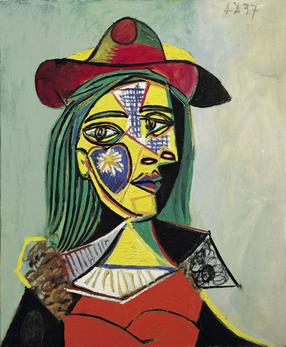art.wikisort.org - Painting
The Woman in Hat and Fur Collar (Marie-Thérèse Walter) is a painting by Pablo Picasso executed in 1937 and exhibited at the National Art Museum of Catalonia (Museu Nacional d'Art de Catalunya) in Barcelona, Spain.
| Woman in Hat and Fur Collar (Marie-Therese Walter) | |
|---|---|
 | |
| Artist | Pablo Picasso |
| Year | 1937 |
| Medium | Oil on Canvas |
| Dimensions | 61 cm × 50 cm (24 in × 20 in) |
| Location | Museu Nacional d'Art de Catalunya, Barcelona |
History
It was painted in Paris in 1937, and is one of the numerous portraits Picasso did of Marie-Thérèse Walter, his lover between 1927 and 1935, approximately, and the mother of his daughter Maya.
In these portraits, Picasso carries out an exhaustive analytic exercise in which the youth and personality of Marie-Thérèse are subjected to a thousand metamorphic transfigurations. The artist merges the frontal view of the face and the profile into a single image and turns the model into an icon of sensuality by means of a rich pictorial language in which the distorted forms marked the consolidation of the so-called 'Picasso style'. The portrait is at the same time epilogue to the confrontation between the two essential models of the moment, Marie-Thérèse and Dora Maar. Despite the distorted forms, the diverging eyes and the angular features, this portrait is easily identifiable, because, like the ones he did at the same time of Nusch, Paul Éluard's second wife, and of Dora Maar, it preserves the sitter's essential features.[1]
The clear connection of Picasso's works and his love life is taken for granted today, and when his art of the early 1930s is discussed, the growing phrased used is "the Marie-Therese period." Picasso's affair with Marie-Therese was a secret, and she would gradually usurp the throne then occupied by Olga Khokhlova, the artist's legal wife. Marie-Therese will be subject to constant transformations. Some range from portraits that are instantly recognizable to transcendent universal symbols. Fantastic reinventions of the human body were always at the core of Picasso's genius.[2] In Woman in Hat and Fur Collar, the artist shows her facial profile and frontal view in the same painting. She is looking to viewers both left and right.
In his work, woman is the vehicle for the expression of intense emotion, but the feelings expressed are those of humanity at large: far from being the other, she is the self.[3]
Collection history
When the MNAC opened in 2004, there were some gaps in content especially with respect to modern artists. One of the most absent was Picasso. The work entered the museum in 2007, one of a set of 8 pieces that are part of a group and fills many gaps in the artist's career.
Details of the work: Oil on canvas Painted in Paris, on December 4, 1937. The painting is not signed but dated as "4D37" in the upper right corner. It is a deposit of State since 2007, the company Albertis Foundation joined the museum MNAC reference number 214090.[4]
Exhibits
In addition to being in the museum's collection, the picture was shown in the following exhibitions: Picasso.
- Picasso. De la caricatura a les metamorfosis d'estil (From caricature to metamorphosis), Barcelona, Museu Picasso 2003.[5]
See also
- List of Picasso artworks 1931–1940
- Dora Maar au Chat
References
- Picasso : de la caricatura a les metamorfosis d'estil. Barcelona: Lunwerg, 2003. ISBN 84-7782-980-2.
- Rosenblum, Robert. "Picasso's Blond Muse: The Reign of Marie-Therese Walter." Picasso and Portraiture: Representation and Transformation. Thames & Hudson, pp. 337-382.
- Daix, Pierre, Picasso: Life and Art, trans. Olivia Emmet, London, thames and Hudson, 1993.
- Picasso, MNAC, 2007
- Picasso, MNAC, 2007
Further reading
- Cristian Zervos : Pablo Picasso, París 1958 vol 9 p.39 lámina 60
- Douglas Duncan, D.: Los Picassos de Picasso, Barcelona, 1961
На других языках
- [en] Woman in Hat and Fur Collar
[es] Mujer con sombrero y cuello de piel
Mujer con sombrero y cuello de piel (Marie-Thérèse Walter), pintado en París el año 1937, es uno de los numerosos retratos que Pablo Picasso hizo de Marie-Thérèse Walter, su compañera sentimental entre 1927 y 1935, aproximadamente, y madre de su hija Maya. En este retrato, Picasso realiza un ejercicio analítico exhaustivo en que la juventud y la personalidad de Marie-Thérèse se someten a mil figuraciones metamórficas. El artista convierte a la modelo en un icono de la sensualidad a través de un rico lenguaje pictórico en el que la distorsión de las formas supone la consolidación del llamado “estilo Picasso”. El retrato constituye al mismo tiempo el epílogo de la confrontación entre las dos modelos esenciales de aquel momento, Marie-Thérèse Walter y Dora Maar. Picasso muestra aquí a Marie-Thérèse mucho más convencional y exenta de dramatismo. A pesar de la distorsión de la forma, la divergencia de la mirada y la angulosidad de los rasgos fisonómicos, este retrato es fácilmente identificable, ya que, como los que hizo en el mismo momento de Nusch, la segunda esposa de Paul Éluard, y de Dora Maar, conserva los rasgos esenciales de la retratada.[ru] Женщина в шляпе и меховом воротнике
«Женщина в шляпе и меховом воротнике (Мария-Тереза Вальтер)» (исп. Mujer con sombrero y cuello de piel (Marie-Thérèse Walter)) — картина испанского художника Пабло Пикассо, написана в 1937 году и представляет собой живопись маслом на холсте размером 61 × 50 см. В настоящее время хранится в Национальном музее искусства Каталонии в Барселоне.Другой контент может иметь иную лицензию. Перед использованием материалов сайта WikiSort.org внимательно изучите правила лицензирования конкретных элементов наполнения сайта.
WikiSort.org - проект по пересортировке и дополнению контента Википедии
